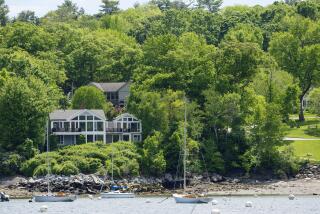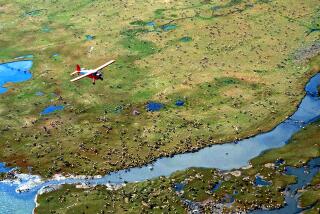Forests at Risk: Shifting the Fight to the Maine Woods : Environment: California’s woods aren’t the only ones disappearing. Now the question is how much control can be placed over private land?
BRUNSWICK, ME. — New England’s wilderness is gone. What’s left is a ragtag forest not worth saving for the national good--or so Westerners may think, accustomed as they are to viewing the grand landscape of the Pacific Northwest and Alaska as the country’s lone wild frontier and vast timber storehouse.
In fact, there remains in tamed, long-settled New England a huge unbroken forest that’s one of America’s greatest natural treasures and wood baskets. The so-called Northern Forest contains 26 million acres stretching from the eastern shore of Lake Ontario to Maine’s most northeasterly point on the Atlantic. This irreplaceable oasis of nature is rapidly becoming the focus of a major national environmental campaign. One aspect alone should make this area--about the size of Virginia--priceless by Western standards: It harbors the last of New England’s old-growth trees. There are 16,000 acres of softwoods and hardwoods such as hemlock and oak, much of it in Maine.
Although almost all the Northern Forest is privately owned, two centuries of sparse population and relatively benign management have left this tier of forests, mountains, lakes and rivers as the largest remaining wild area in the East. Landowners have largely conserved the public’s interest in open space, aesthetics, wildlife habitat, clean water and recreational access.
But the strain of overpopulation, second-home development, massive clear-cutting and pressures from Wall Street on longtime owners to sell are threatening to change the Northern Forest’s face and character. The forest increasingly has less market value as timberland than its value as house lots.
National environmental groups have rushed to the rescue, issuing a coast-to-coast call to arms to protect the Northern Forest for all time. National Audubon Society official Brock Evans promises that the campaign will be even bigger in the next few years “than the ancient forest campaign we’re just going through in the Pacific Northwest.” The Wilderness Society and Audubon, the campaign leaders, propose federal acquisition on a large scale because it offers the greatest protection. Their vision is a new national park, national forest or refuge covering a substantial amount of the Northern Forest, with other kinds of conservation agreements to protect the remainder.
There’s little doubt that the outcome of this campaign may establish a national model for forest use and protection where private ownership predominates. Whose woods are they, when, although deeded to a private party, they contain significant national and state resources owned by the public? How far can the public go in limiting decisions and forest practices of present-day owners? What economic burdens are reasonable to place on taxpayers to help large corporations keep their forest holdings? What rights should these corporations yield in return? The fight could settle in the Northeast, perhaps forever, whether there will be any large-scale land preservation.
What’s happening in the Northern Forest is a historic transformation. For generations, millions of acres have been held by a dozen companies, families and trusts. Traditionally, the land has been used to grow timber and was open to the public for skiing, hunting, fishing and camping. In the golden ‘80s, the expansion of interstate highways, the economic boom and deteriorating city life sent hordes of urban dwellers scurrying to the Northern Forest for recreation and to buy a little wilderness before it was gone. Speculators bought large tracts, chopped them into house sites and sold them for four, six, 10 times the value they had as timber-growing land.
At the same time, major forest land tracts held by big corporations began to change hands. The first big turnover was 1.6-million acres owned by Diamond International in New York, New Hampshire and Maine. The sale to speculators and developers plainly demonstrated the close link between Wall Street and the future of the Northern Forest. Taking note of the profits Diamond made, other big landowners inventoried their tracts around scenic lakes and ponds and put out for-sale signs.
The situation propelled the Northern Forest onto the public agenda. Congress conceded the critical importance of the region’s forests for jobs, recreation and wildlife and appropriated $250,000 for a U.S. Forest Service study of the threats and challenges. A 12-member task force was appointed to help the Forest Service with a national forest lands study. Given the power of the paper companies, it wasn’t surprising when the task force was stacked with pro-industry members.
As the study began, another lightning bolt struck. Georgia-Pacific Corp. pulled off a hostile takeover of Great Northern Nekoosa, the largest owner in Maine with 2.1 million acres. In one fell swoop, 10% of Maine traded hands. Not long after G-P’s buyout, radical environmentalists emerged, for the first time in the region, carrying out civil disobedience and ecotage to draw attention to environmental protection. An Earth First! affiliated group spiked some of the last unprotected old-growth trees in Maine to prevent them from being logged, and sent a shiver down the spine of flinty Yankees who decried them as would-be murderers.
Environmentalists had hoped the congressional report would be a catalyst for bold conservation actions. And, indeed, it has made a case for immediate action to secure the public interest in the Northern Forest. The study confirmed that the ownership pattern that helped maintain the Northern Forest is coming unglued; that regional and global pressures are forcing large landowners to maximize the financial return on land assets; that clear-cutting, road building, pesticide use and other industrial forestry activities are undermining the ecological health of the forest, and that mushrooming demand for outdoor recreation is straining the capacity of state parks.
But there were no visionary recommendations. The industry-friendly study group issued a well-worn plea for tax breaks to give major landowners a good reason not to sell out. The final report declared the public lacks the money and the will to buy land these days because of the sad state of economy. Industry was pleased as punch, agreeing it is the rightful steward of the Northern Forest, despite its history of abusive logging.
The fledgling radical group, Preserve Appalachian Wilderness, or PAW, issued an antidote to the pro-industry study. Its more far-sighted, although politically impossible, plan defined an ecologically responsible strategy to restore native biological diversity to the Northern Appalachians. PAW’s grand vision is the creation of an evolutionary preserve that would make it possible for the wolf, cougar and other big predators to return.
The Wilderness Society’s regional director, Michael Kellett, says the fight has only begun. Environmentalists are considering hot-wiring the situation by proposing to Congress a Northern Forest Protection Act that would mandate federal funds for acquisition.
With the real-estate market having bottomed out, time, which was the enemy, appeared to be the forest’s ally. But the Georgia developer who bought the Diamond land in New York has recently put up for sale 87,000 acres of Adirondack land that New York State wants to preserve as wilderness but says it can’t afford to buy now. “This bursts the bubble of the people who are saying, ‘Don’t worry, with the economy down, what could happen?”’ says Bernard Melewski of the Adirondack Council, a private environmental group.
In other words, public acquisition of forest land must be accomplished. Time is critical. If complacency, excuses or indifference take hold, with the recession as an excuse, no future generations will ever be able to repair the loss.
More to Read
Sign up for Essential California
The most important California stories and recommendations in your inbox every morning.
You may occasionally receive promotional content from the Los Angeles Times.









